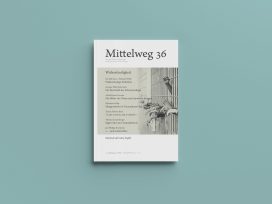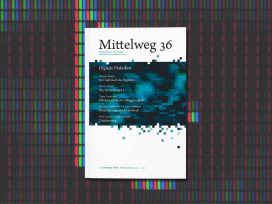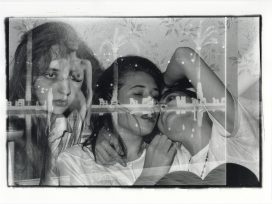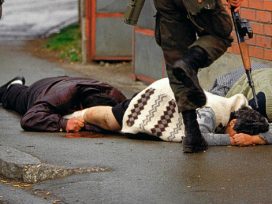In his highly influential book Thinking Photography (1982) Victor Burgin famously warns artists not to succumb to the romantic myth of inspiration and originality. He argues that as all artistic “creation” necessarily depends on pre-established codes and norms, naïve intuition is an insufficient basis for the creative process. Drawing on Walter Benjamin¹s essay “The Author as Producer”, he insists that artistic representations should always include a reflective stance with regard to their own conditions of production. In retrospect this can be seen as one of the most consistent basic premises of his work.
Hilde Van Gelder: You figure prominently among a pioneering group of artists that, as of the late-1960s, rejected American Modernist aesthetic ideals. In your comments on the writings of Clement Greenberg and John Szarkowski you dismantled their critical position as formalist and their theory as detached from reality. What you seem to have disliked most in Modernist discourse was the belief its adherents seemed to express in “the ineffable purity of the visual language” – a conviction that you trace back to a Platonic tradition of thought in which images have the capacity to reveal mystic truths enshrined in things “in a flash, without the need for words and arguments”. I wonder if you can say today, some 30 years later, how exactly you feel that words in your work have come to counteract such illusions of pure visibility of the image?
Victor Burgin: I do not believe, or rather no longer believe, that my work can “counteract” such illusions. Although I realize that your question refers to my photo-text work, I can perhaps more directly answer it by reference to my written work. At the time of Thinking Photography I thought that a more broadly informed photographic criticism would eventually dispel the unexamined assumptions that then dominated writing and talking about photography. The notion of the “purely visual” was prominent amongst these, as was the naïve realist idea that photography is a transparent “window on the world”. The former belief dominated “fine art” photography at that time, while the latter provided the ideological underpinning of “social documentary”. When I first started to teach film and photography students, after having first taught in an art school, the “art” and “documentary” approaches were mutually antagonistic – ironical, given the fact that their founding assumptions are different formulations of the same Platonic idea. The Film and Photography department where I went to teach in 1973 (the London Polytechnic – ed.) was at the time one of only two schools in the UK openly dedicated to a documentary project and hostile to “fine art” photography. The BA theory course I was asked to construct there, of which Thinking Photography is a trace, did for a while succeed in putting critical discussion – the “reflective stance” you refer to – in place of the acting out of inherited ideologies. But that period is now, as a friend of mine put it, a “parenthesis in history”. There has since been a massive return of “previous” frames of mind that had never in fact gone away, even among some of those who participated in the initial project – as if the mere fact of having acknowledged the validity of the arguments advanced in the 1970s and 1980s now provides exemption from acting in response to them. In retrospect I can see – which should not surprise me given my theoretical inclinations – that reason rarely prevails where there are professional and emotional benefits to be derived from irrationality. We are again confronted, as so often, with the psychological structure of disavowal: “I know very well, but nevertheless…”.
HVG: You conclude your essay “Modernism in the Work of Art” (1976) by stating that the “division of labour” between “theorists” and “practitioners” is problematic. In 1986, you add to this that the main problem of this divide is that it hinders people’s attempts “for a truly critical cultural initiative”. The label “critical”, or stronger even, “political” art, has often been attached to, particularly, your earlier practice. It seems, however, that with regard to your work, this notion needs some clarification. It seems doubtful that you would agree with your art being identified as “critical realist”, a term Benjamin H. D. Buchloh coined in 1995 in order to describe Allan Sekula’s photography.
VB: I have heard references to the time when my work “used to be political”. My work has never ceased to be political, what has changed is my understanding of the form of politics specific to art, rather than, for example, investigative journalism or agit-prop. Benjamin Buchloh’s expression seems to me a symptom of the disavowal I just cited, not least because the issue of representation has simply dropped out of the picture. Beyond the attempt to rebrand what used to be called “social documentary” it is difficult to see what work the expression “critical realist” is intended to do. Either of the two terms Buchloh associates requires careful specification. To simply conjoin them as if their meanings were self-evident is inevitably to fall into complicity with the doxa – in terms of which to be critical is to criticize. Here the “critic” assigns the “artist” a position analogous to the one he himself assumes – that of a literally exceptional person who surveys, discriminates and judges. Where such a position is assigned we do well to ask if there are not blind spots in the critical view.
In the early- to mid-1970s, when my work had an unambiguously obvious political content, there was very little such work in the art world. Forty years later, “political art” is the new orthodoxy, but it is “political” only in the way the media understands the term. For example, the enthusiasm for “documentary” in the art world of the past quarter-century has provided a spectrum of gallery-sited narratives – from intimately anecdotal “human interest” stories to exposés of the devastation of the human and natural environment by rapacious global capitalism. But there is nothing in the content or analysis of these stories that is not already familiar from the mass media, and I have seen only insignificant departures from conventional media forms. Such “artworks” solicit the same range of interests and the same reading competences that the media assumes in its audiences. Complementing “documentary” work in the art world are other kinds of work offering spectacle, decoration or scandal. Here again we have not left the discursive space of the media, we have simply turned the page or changed channels.
Brecht defined “criticism” as that which is concerned with what is critical in society. My own sense of what is now fundamentally critical to the western societies in which I live and work is the progressive colonization of the terrain of languages, beliefs and values by mainstream media contents and forms – imposing an industrial uniformity upon what may be imagined and said, and engendering compliant synchronized subjects of a “democratic” political process in which the vote changes nothing. The art world is no exception to this process. Artists making “documentaries” usually encounter their subject matter not at first hand but from the media. The audience for the subsequent artworks will instantly recognize the issues addressed, and easily understand them in terms already established by the media. What is “documented” in such works therefore is not their ostensible contents but rather the mutating world view of the media, and they remain irrelevant as art if they succeed in doing no more than recycle facts, forms and opinions already familiar from these prior sources.
I would emphasize that I am talking about documentary in the art world. As I write, the Iranian filmmaker Jafar Panahi is in prison – primarily, it seems, because he was making a documentary about the mass protests that followed last year’s dubious elections in Iran. The political value of documentary is conjunctural, context is as important as content. The political value of art primarily bears on neither content nor context but upon language. I see no point to “art” that calls upon the same general knowledge and interpretative capabilities I deploy when I read a newspaper.
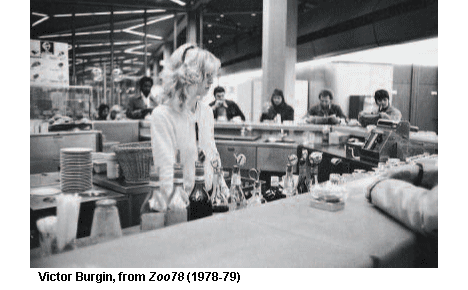
HVG: What about the other word in Buchloh’s expression, “realism”? Arguably, your work Zoo78 (19781979), consisting of eight photo diptychs that quite explicitly address the Cold War situation in Berlin, can be seen as a turning/closing point in your view of realism. I say “arguably” because in 1987, in an essay entitled “Geometry and Abjection”, you launch a plea for a “realist” artistic project. However, you now define this project in terms of “psychical realism”, an expression you take from Sigmund Freud. The term already takes a central position in your essay “Diderot, Barthes, Vertigo” (1986), where you argue that “psychical-reality”, “unconscious fantasy structures”, constantly exercises “its effects upon perceptions and actions of the subject”, such that the world can never be known “as, simply what it is“. To what extent do you still rhyme this notion of psychical realism with your earlier emphasis on art’s function as cultural critique? In other words, can you articulate the kind of socio-cultural reflection you wish to put forward through your work ever since the concept of psychical realism has become one of its principal motors?
VB: The British philosopher Gilbert Ryle long ago commented on the habitual distinction in which “reality” is seen as something separate from our “inner” lives. In terms of this distinction we simultaneously inhabit two parallel worlds – one private and psychological, the other public and material. In this view the expression “psychical reality” would be an oxymoron. Ryle noted however that in this version of our experience of the world, there is no way of accounting for the transactions that take place between public and private histories, as by definition such transactions belong to neither of the “two” worlds. There is therefore no account of how individual subjects become inserted into general political processes – except in terms of such now largely redundant categories as “class consciousness”. What Ryle did not note, but might well have done, is that the distinction between private and public is hierarchical – as when “subjective fantasy” is subsumed to “objective reality”. With the idea of “psychical reality” Freud in effect “deconstructs” this hierarchy. Anticipating Derrida’s critique of the “logic of the supplement”, Freud shows how the “supplemental” category, that which is considered as superfluous and undesirable, is at the very heart of the category that is upheld as primary and essential.
I see no contradiction between a commitment to art as cultural critique and a taking into account of psychical reality. The British cultural and political theorist Stuart Hall said that his attempts to understand the mass appeal of Thatcherism had led him to conclude that the logic of the appeal was not that of a philosophical argument but rather the logic of a dream. To take a more recent example, Michael Moore’s film Sicko – a damning account of the US health care system and the pharmaceutical and insurance industries that benefit from it – was released in 2007 to enormous acclaim, quickly becoming the third largest grossing documentary film of the past 30 years. Barack Obama was elected US president the following year and, since then, has encountered overwhelming opposition to his proposed health care reforms from the very people who have most to gain from them. As the US expression succinctly puts it: “Go figure.” If nothing else, this recent history might have prompted a little self-reflection on the part of “political artists” who see their work as “consciousness raising”. Not only is there something inevitably patronizing in the attitude of artists setting out to raise other consciousnesses to the level of their own, but also the exercise is generally futile – either the mass of the people “know very well, but nevertheless…” or their consciousnesses are the unique and unassailable product of the populist-tabloid Fox News Channel.
HVG: In your work in the 1970s you often drew directly on codes and conventions of the media, especially advertising, to make ironic comment on various kinds of exploitation and inequality, such as in UK76, where in one of the panels you insert an excerpt from a fashion magazine into a photograph of a female Asian factory worker. You now say you conceive differently of “the place of the political in art”. In this regard you cite Jacques Rancière, who says that “aesthetics has its own meta-politics”, as a privileged ally in your own attempts to understand how art relates to politics and ideology. You conclude by insisting that “the political meaning of attempts […] to give aesthetic form to a phenomenological truth or a psychical reality […] may lie precisely in the ways in which they fail to conform […] to established regimes of intelligibility”. Could you elaborate on this?
VB: Art, at least in our western populist liberal democracies, has no direct political agency. When I joined the protest march against the Iraq war in London, when I joined demonstrations against the National Front in Paris, I acted as a citizen, not as an artist. (By the way, it does seem that the days when street protest could have a real political effect have now passed into history.) When I refused to cooperate with “obligatory” but intellectually ridiculous government research assessment exercises, when I refused to join a “compulsory” training day for academic staff run by a private management training consultancy, I acted as a university teacher, not an artist. The work of “political artists” usually harms no one, and I would defend their right to make it; what I cannot support is their self-serving assumption that it “somehow” has a political effect in the real world. In a university art department, I would prefer as my colleague the artist who makes watercolours of sunsets but stands up to the administration, to the colleague who makes radical political noises in the gallery but colludes in imposing educationally disastrous government policies on the department.
The political agency of artists is not “on the ground” in everyday life – at this level they must be content to act as citizens and/or, in my example, teachers (I have always considered teaching to be my most important political activity) – their agency is in the sphere of representations. Since the work to which you refer, and up to the present day, I have measured the political and critical dimensions of my work by their relation to the mainstream mass media as the media is most responsible for the production of subjects for the political process, most instrumental in delivering votes to politicians. You are nevertheless right to note that my position in relation to the media has shifted. My initial position combined Lévi-Strauss’ notion of “bricolage” with Barthes’ idea of “semioclasm”. For example, the panel we have already mentioned from UK76 juxtaposes fragments from two disparate and “antagonistic” discursive formations – social documentary photography and fashion journalism – in order to bring out a social contradiction. The problem I see with this now is that it leaves the fragments intact, and what one is able to construct – to “say”– depends entirely on what it is possible to do with the fragments. No great surprise, therefore, that what I was able to say with this particular panel of UK76 was already well known, and that the only “value added” element to the source materials was my own irony (albeit there was also a cultural-political significance at that time – it was relatively short lived – in putting such content on the wall of a gallery).
As I have already said, I see the critical task of art today as that of offering an alternative to the media. I am opposed to any form of conformity to the contents and codes of the doxa – what Rancière calls “consensual categories and descriptions” – even when these are deployed with a “Left” agenda, as I believe that in this particular case “one cannot dismantle the master’s house with the master’s tools”. At the present conjuncture it seems to me that society is most present in an artwork – as a critical project – when the artwork is most absent from society.
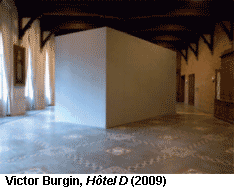
HVG: If we can turn then to your more recent work: Hôtel D (2009) is a site-specific piece consisting of a digital projection loop inside a box installed in a principle room of the ancient former pilgrims’ hospital, Hôtel-Dieu Saint-Jacques, in Toulouse, once known as the “salle des portraits des bienfaiteurs“. Could one understand this “sequence of images” as a “sequence-image”, a term you have defined earlier in your writings; and more recently in conversation with Alexander Streitberger, where you call it “both the elemental unit from which chains of signifiers are formed and the hinge between movement and stasis, the motionless point of turning between unconscious fantasy and the real”?
VB: The short answer to that question is “No”; the “sequence-image” is a purely theoretical entity. I coined the expression to allow me to talk about an image that is neither still nor moving or, to put it the other way, both still and moving. The fact that such an image is by definition impossible signals its location in psychical space, on the side of the unconscious, where the “law of excluded middle” does not apply (as when a woman in a dream is both the dreamer’s mother and sister). I coined the neologism reluctantly but there was no other way of speaking about what for me is an important aspect of the “psychical reality” I try to represent. The material images projected in the Hôtel-Dieu, and the material sound of the voix-off in the adjoining chapel, were combined in an attempt to represent the strictly unrepresentable. Each new work renews this attempt, making its singular contribution to the generality at which I aim.
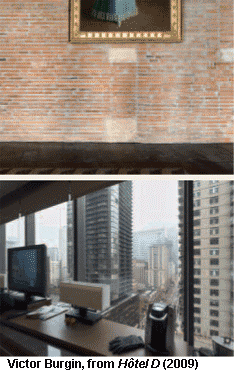
I think by analogy of an old movie version of H. G. Wells’ The
Invisible Man where a number of devices are used to signify the invisible man’s form – for example, in one scene, some trash whirls into the air on a windy street and sticks to him; in another scene, disembodied footprints advance across a snow-covered field. We would not say that either the trash or the tracks are the invisible man, but they are the more or less contingent conditions of his “appearance” in the visible world. Hôtel D, in common with all of my works in recent years, is an attempt to represent some unrepresentable “thing” – in this case deriving from my being there, in the Hôtel-Dieu in Toulouse, and being aware of the lives and deaths of those who were there before me, aware of the past function of the building, and at the same time aware of the forms of the architecture, of the time it takes to cross the room – everything, in fact, at the same time, including the connotations and fantasies that accompanied my perceptual experience and knowledge of the place.
HVG: Hôtel D offers itself as a key case study in order to understand your interest in “perceptual reality”, as you name it in your “note” accompanying the piece. The research component of this interest brings in the “historical identity” of the place as a space of labour for the “filles de service” the female hospital orderlies. The sequence of images and the spoken text testify to a paradox encountered in your own initial observation of the reality of this room. Among the five large portraits of illustrious historical benefactors of this establishment you found an equally monumental picture of a woman identified only as “fille de service“. The image of this woman, named at the bottom of the portrait itself as Marguerite Bonnelasvals (Ý1785), is exhibited together with the other portraits, which are all of people of a higher social rank. Facing Marguerite Bonnelasvals, as you point out, hangs a tableau of Princess Marie-Thérèse de Bourbon, daughter of Louis XVI and Marie-Antoinette. This striking finding, a result of your scrupulous perception and observation of the place, is a key theme in Hôtel D. Can you perhaps clarify how, from a strictly methodological point of view, you decided to focus your work on this quite incredible coincidence?
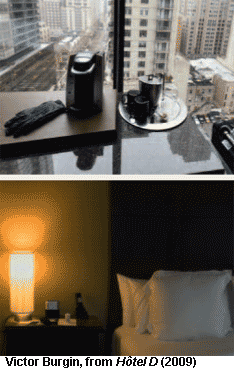
VB: In the perceptual and associative complex that is my experience of a place there is often a privileged point around which everything else turns. It might be a detail, an anecdote or something else. The juxtaposition of the two portraits in the Hôtel-Dieu became this point of anchorage for everything that made up my awareness of the place. One of the things that interest me is the way “the political” may be manifest as a mutable aspect of our everyday reality, on the same perceptual basis as the changing light, an aching knee or a regret. The coincidence of the portraits is a trace of the political in the overlooked, and therefore part of what I look for in the everyday. There is no need for the western political artist, too often a disaster tourist, to “sail the seven seas” looking for injustices to denounce. Inequality and exploitation saturate the ground on which we stand, they are in the grain of everyday life. This granular-perceptual manifestation of the political is part of what I try to represent in my works.
HVG: I have come to understand Hôtel D as a work that brings together all the major themes and preoccupations of your oeuvre. With the concept of psychical realism entering your work, your interest in the representation of women entered the foreground. Many of your pieces, as of the early 1980s, take account of the impact of male desire on female perception and vice versa, and the issue of sexuality and sexual difference in general. You have emphasized the influence that 1970s feminism exercised on your artistic trajectory, for example in the attention in your work to “the construction of gendered identities through identifications with images”. Now, in Hôtel D, the long-lasting key importance you have accorded to this very subject appears to engage in a dialogue with an interest you have had, in an even earlier phase of your work, with regard to the representation of labour. Many contemporary artists have taken on the problematic consequences of currently globalized labour conditions by directly representing people at work. Whereas the atmosphere of UK76 seems to have something in common with such an approach, you have later come to take the representation of labour in your work in a different direction.
VB: I do not understand how “directly representing people at work” can be said to “take on” the issue of the globalization of the labour force – at most it can only redundantly illustrate it. Amongst other things, the issue is fundamentally one of organizing collective action across cultural, linguistic and legal international borders. How can adding more pictures to the mountain of images of the labouring classes have any relevance to such questions, let alone any purchase on them? And what about the act of picture-taking itself? As your reference to UK76 invokes the historical perspective, I would like to quote what I said in an interview from the late 1970s when I was asked how I felt about the power relation between myself and the Asian woman worker whose image appears in this work:
I’d been commissioned to take photographs by the Coventry workshop, they were working with various other local workers’ organizations and they wanted someone to take some pictures in some of the factories around Coventry. It was in that capacity that I took that particular picture: it was not shot as a work of art but as something for their publications and their files… No one was photographed who didn’t want to be. Some obviously didn’t feel comfortable with the camera on them, so I didn’t take photographs of them, but others obviously enjoyed being the centre of attention. I was a source of entertainment for them for the afternoon. Having said all that, the fact remains that I was free to walk out of that place and they weren’t – a fundamental distinction. The work I was doing was intended to support them, the same goes for the art piece that some of the images were subsequently used in, but the fact remains that my intervention there, if not actually exploitative, was politically irrelevant; that’s how I feel about it now, and that’s how I feel about the work of other “artists” who take their cameras into such situations.
Under what circumstances is it acceptable for a middle-class photographer to point a camera at a wage-slave? A campaigning journalist, illustrating a news story that might mobilize public opinion and embarrass corporations and politicians into changing their behaviour, is certainly justified, but I find something profoundly distasteful in the spectacle of workers having a last increment of value extracted from them by “political artists” parading their moral narcissism in pursuit of their careers.
HVG: In your photo-textual work Office at Night (1986), the “psychical” component has already entered the very depiction of labour. The work prominently focuses on male-female power relationships in the work place. It’s extremely dense, sexually and power(less)-loaded atmosphere differentiates it from Jeff Wall’s more neutral photographic depictions of labour, not least with regard to the so-called “iconography of cleaning up”, an issue I would like to come to in a minute. In Hôtel D, the representation of labour is only indirectly present, as this was already the case in your Performative/Narrative (1971), a phototextual piece that shows an empty office of a male employer (as the accompanying text indicates). In Hôtel D it is not so much in the sequence of images itself but rather in the “voix-off” – the voice heard in the adjoining chapel – that the humble work of cleaning up is more explicitly addressed.
The voix-off operates “in parallel” to the images, as Philippe Dubois has argued with regard to other of your works with a similar approach. The sequence of images shows the perfectly tiled floors, walls and ceiling of the “salle des portraits des bienfaiteurs“, and a perfectly clean hotel room – although subtle details, such as a playing TV, luggage, gloves on a desk and a bottle of pills besides the bed, reveal it is in use. Yet for a major part of the eight-and-a-half minutes-long parallel audio-sequence a woman’s voice slowly describes the repetitive activities of making a bed and cleaning a hotel room. I wonder if this, by definition, “non-iconographic” soundtrack can be understood as performing a double function in your work. I feel that its descriptive character can be seen as programmatic with regard to your decision, articulated one year after Office at Night, in “Geometry and Abjection” (1987), that a “political” theory of art should simply “describe” rather than exhort or admonish, or offer “solutions”.
VB: Perhaps I should first describe the work, as it is unlikely that anyone reading our exchange will have seen it. Hôtel D comprises four components: the two actual spaces in the Hôtel-Dieu, an image-track and a soundtrack. The image sequence assembled from the photographs I made in the Salle des Pèlerins is projected in a continuous loop in a “viewing box” constructed inside the Salle itself. The room represented in the box is therefore a mise-en-abyme of the room that contains the box. The “work of art” here is in good part a work of the visitor in a coming and going between the experience of the actual rooms and their representations. There is an analogous coming and going between the real and projected images in the Salle des Pèlerins – as you have noted, formerly the “salle des portraits des bienfaiteurs” – and the voice heard in the adjoining space of the Chapel. Rather than “voice-over”, the equivalent French expression “voix-off” is more appropriate here as the text is heard not over the images but at a distance from them. Hôtel D is the product of a reflection upon the “perceptual reality” of the Salle des Pèlerins – as I experienced it and as it is refracted through the photographs I made there – and upon the historical identity of the room as a place of care for the sick and dying, a place of work for the “filles de service“.
Another axis of my work – prompted by the historical function of the Hôtel-Dieu as a place of rest for the pilgrim – is formed in a coming and going between associations to the meaning of the term “hôtel” in this particular building in Toulouse, and to the more usual meaning of the term in everyday use today. Images of a hotel room in a modern city (in actual fact, in Chicago) therefore come to join my images of the Salle des Pèlerins. Similarly, in the voix-off, references to the repetitive routine task of bed-making occur in both a hospital and a hotel setting. Hôtel D is not “about” such things in the way that either a documentary or a fiction film might be about them. It is a work best considered not as one might view a film, but rather as one might approach a painting.
HVG: You have in fact said that the spectator should try to view the complex perceptual installation called Hôtel D as a painting in which you see “everything and nothing at the same time”. Could this statement perhaps help to grasp what you have elsewhere identified as the “uncinematic feel” of your video practice? Also, in order to better understand this fascinating concept of the dispersed painting or tableau, to be discovered layer by layer in a mode of “reprise”, as you call it, would it be helpful to recur to an analogy with the notion Allan Sekula coins for several of his works, namely that they are “disassembled movies”? Could we say with regard to Hôtel D that it is to be considered as a “disassembled tableau”?
VB: In the 1970s I used to speak of my large-scale photo-text works as the remnants of hypothetical films – for example, I described US77 as “a sort of static film” where the individual scenes have collapsed inwards upon themselves so that the narrative connections have become lost”. However, I also at that time spoke of the viewing conditions of such works as being the “negative of cinema”; for example, in the cinema the spectator is in darkness whereas the gallery is light; the cinematic spectator is still while the images move, whereas the visitor to the gallery moves in front of static images; or again, the sequence and duration of images in the cinema is predetermined, whereas visitors to the gallery determine their own viewing times and sequences. Or again, there is little opportunity for reflection during the course of a film – Barthes says the cinema “does not allow you to close your eyes” – whereas my work in the gallery solicits active reflection on the part of the viewer/reader. To take such differences into account is to pay attention to the specificity of the practice – that which distinguishes it from other neighbouring practices.
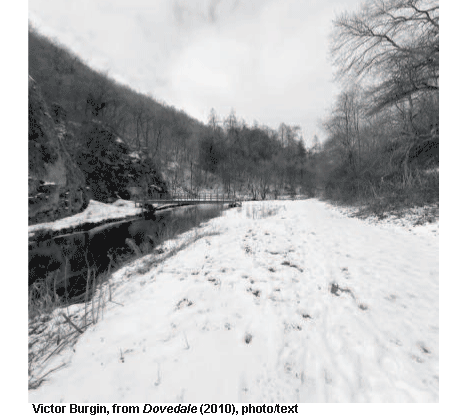
For example, one of my constant technical concerns is with the elaboration of forms of language adapted to the situation of reading or listening in the gallery. In general I aim for texts that condense relatively large amounts of information into small spaces, and which allow readers to bring their own associations to fill out the meanings of the laconic texts. Most of the time this requires little more than an attention to economy of expression. For example, the opening sentence of the voice-over to my most recent work, Dovedale, which is currently exhibited in Cologne, reads: “The major museums are all close to the station, which is by the cathedral so I cannot get lost.” This sentence establishes that the speaker is a stranger to Cologne, there to visit the museums, and it also documents a material fact about the city. So far, I might be writing a short story. However, although I referred to this as the “opening sentence” of my text, it is not necessarily the opening sentence for the visitor to my installation, who is free to come and go at any time during the continuously looping audiovisual material. A specific requirement of the voice-over text therefore is that it be written so that any sentence may occupy the position of “first” sentence. Now although the words and images that make up my work are necessarily deployed in time, my accommodations to the indeterminacy in their viewing and reading in effect breaks up and spatializes the temporal flow – so your expression “disassembled tableau” may fit my work quite well.
There is a further “disassembling” in the material condition of the work as a number of separate but interrelated “bits”. In Cologne, my moving projection-sound piece is accompanied by a still photo-text work based on photographs I made in the Peak District in Derbyshire, England, at the place depicted in Joseph Wright’s landscape painting Dovedale by Moonlight (1785), which is in Cologne’s Wallraf-Richardtz-Muzeum. There is a “scattering” of references to the painting here analogous to that of the scattering of a film in the “cinematic heterotopia” I name and describe in my book The Remembered Film (2004). All of this is related to my interest in what I have termed the increasing “exteriorization” of psychical processes in everyday life – especially the “prosthetic memory”, and perhaps even prosthetic unconscious, that the Internet increasingly represents. It was with such things in mind that I was struck by the remark by the painter Pierre Bonnard, who said that he would like the experience of his pictures to have something in common with the experience of first entering an unfamiliar room – one sees everything at once, and yet nothing in particular. What I want to add to Bonnard’s purely optical picture is the fleeting concatenation of impromptu thoughts one may have at that moment – which of course may include what I have already referred to as the “granular-perceptual” manifestation of the political.
HVG: I would like to end with some questions on a more institutional topic. You have recently spoken of art departments that share “a history of research initiatives”. By this, you seem to imply that the new “art-as-research” initiatives popping up in these departments are in fact not so new at all. To what extent can you agree with the assertion one often hears that it is Conceptual Art that provided the fundamental impetus to the research-based developments that have now become bon ton not only inside many art departments but increasingly also in the broader artistic discourse? Are there, according to you, other historical elements that are perhaps more easily overlooked but that should also be taken into account in order to understand the new research-related dynamics the art world experiences nowadays? Also, as you have repeatedly expressed your concern with regard to the “universal hegemony of global capitalism, and its preferred form of political expression, neo-liberalism”, do you think that the insertion of “market values and relations” into what you call the “previously alternative” spaces of the university and the art institutions” can also partly be held responsible for the developments in academia that are now more prolifically described as artistic research? To what degree can we say that the academicization of the arts brings with it a new logic of financial gain for institutions that traditionally used to cherish a non-profit logic, parallel to and in competition with the already-existing one of the galleries?
VB: In the sentence you quote from my article I am referring to those artistic initiatives, mainly in the 1960s, that were self-consciously associated with scientific research – for example, the projects undertaken by the group “Experiments in Art and Technology” (EAT) in the USA. Outside these initiatives the word “research” was rarely used in art schools at that time – one was more likely to hear talk of “creativity”. It was only when I began to teach in a British art department in 2001 – after 13 years in the Humanities at the University of California – that I encountered such expressions as “research-led practice”, “practice-led research”, “practice-as-research”, “research-artist” and so on. In the interim, the terminological shift from “creativity” to “research” had been brought about by political and economic necessity rather than intellectual self-searching. The idea that “Conceptual Art” was responsible for this shift simply shows how incapable the self-obsessed “art world” is of understanding the real historical determinants of its own condition. In Britain in the 1970s, the previously autonomous “colleges of art” were incorporated into newly-formed, multi-disciplinary “polytechnics” that from 1992, under the Conservatives, were rebranded as “universities”. In order to receive government funding, art departments then had to meet the same kinds of criteria that were applied to the assessment of other university departments – with quantity and quality of research foremost amongst these. It was then that, somewhat in the manner
of Molière’s Monsieur Jourdain, the former art schools found they had been doing “research” all their lives.
What you call the “academicization” of the arts would have been anathema to the old art schools, where the reigning ethos was rigorously anti-intellectual – I think of the painter Barnett Newman’s remark that philosophical aesthetics, to him, was what ornithology must be to a bird. The drive of successive British governments for standardization and centralized control of the universities not only imposed fundamentally alien and incompatible academic practices on the old art schools but, more perniciously, also undermined the very meaning and culture of research in the universities; in the same historical moment that the art schools were entering the university research environment, this environment itself was radically changing. When I first started teaching in Britain the art colleges and universities were under the “Ministry for Education and Science”, they are now administered by the “Department for Business, Innovation and Skills”. I am speaking of the British example, but there are comparable tendencies throughout Europe, such as the “Bologna Process” initiative to establish a “European Area of Higher Education”– an intellectual equivalent of the Common Market which has much the same economic-instrumental values and goals. In Britain, a government-appointed body has recently set out a “Research Excellence Framework” for the assessment and funding of research that makes short-term “outcome” in terms of demonstrable “impact” on society the primary funding criterion: in the sciences, “impact” will mean measurable technological and economic benefits; in the arts and humanities it can only mean measurably visible publicity and entertainment value – assessment of which will inevitably defer to the media. In fact, for some long time now the art world and the art departments have provided media-ready art much as supermarkets provide oven-ready chickens. The mainstream media has become increasingly populist over the past quarter-century or more, a process that was at first commented on, to again take the British example, in frequent references to the “dumbing down” of the “quality” press – now a fait accompli that no one mentions any longer. This consequence of the political demagogy of the Thatcher-Blair years was accompanied by a new demagogic spirit in art – incarnated most visibly by Charles Saatchi and his protégés – and a corresponding mutation in the audience for art. The art world congratulates itself on the fact that art today has a larger audience than at any time in its history – but this is simply an epiphenomenon of the increasing mediatization of art. As the saying goes, “we get the art we deserve”, and it is increasingly apparent that we will get the universities we deserve too.
The meanings and aims of both art and academic research are being harmonized with those of ordinary “non-élitist” everyday common sense. I met a routine manifestation of this the other day when I went into my local organic food store to buy sweet potatoes. I had bought some there the previous week, and they had been labelled with Spain as their country of origin. I picked up a couple of them and took them to the counter, but I noticed that the label was gone. I asked the woman behind the counter if these sweet potatoes were also from Spain. “They’re from Israel,” she said. “Then I don’t want them,” I replied. “Oh,” she said, “the farmers are not the government. They just want to make money, like the rest of us.” She said this in a tone and with an expression that made it clear she believed she had made an argument to which there was no possible reply – and in fact it left me speechless. She spoke exactly as she might have if she had said: “They just want peace, liberty and happiness, like the rest of us.” How could I argue? To “make money” is our fundamental desire and inalienable right, it guarantees our common humanity, it’s what joins each atomic individual to “the rest of us” – what hope is there for either art or the university if this mind-set prevails?








